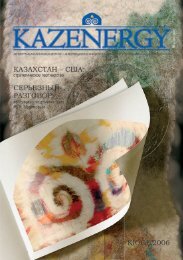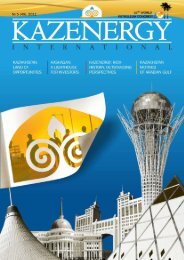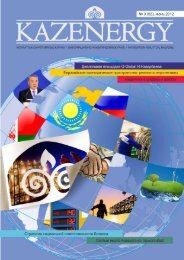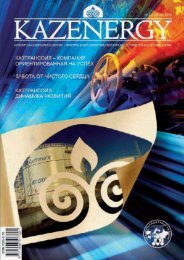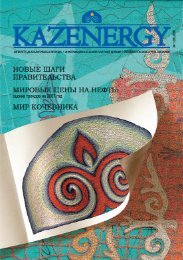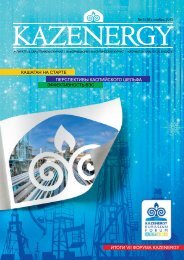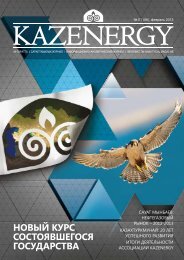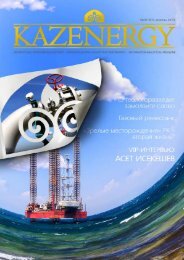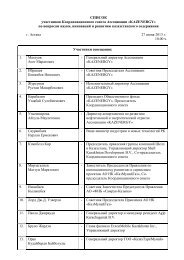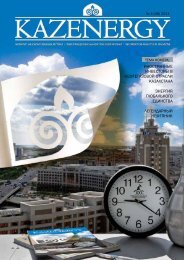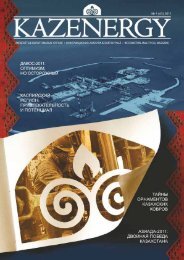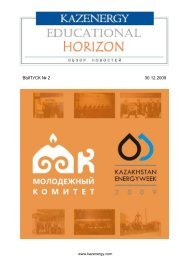KAZAKHSTAN UPSTREAM OIL AND GAS technology and R&d ...
KAZAKHSTAN UPSTREAM OIL AND GAS technology and R&d ...
KAZAKHSTAN UPSTREAM OIL AND GAS technology and R&d ...
You also want an ePaper? Increase the reach of your titles
YUMPU automatically turns print PDFs into web optimized ePapers that Google loves.
4.2 Field management: optimised recovery including IOR/EOR<br />
90<br />
Solutions commentary<br />
The ultimate goal in this area is to increase<br />
oil production from existing assets through<br />
improvements in reservoir engineering.<br />
Stimulation techniques are intended to restore<br />
well productivity that has been reduced<br />
by bottom-hole zone damage, the result<br />
of poor well packing, asphaltene/resin/<br />
paraffin deposits, scaling, etc. The objective<br />
is to deal with these problems <strong>and</strong> restore<br />
initial production <strong>and</strong> water intake capacity.<br />
Techniques include treatment with hot water,<br />
condensate, hydrochloric acid, steam,<br />
surfactants etc.<br />
To select the optimal chemical for bottom-hole<br />
treatment, a core analysis must be carried<br />
out <strong>and</strong> the bottom-hole zone modelled<br />
to test the intended treatment. Based on<br />
laboratory results <strong>and</strong> the modeling work,<br />
recommendations can be made for pilot<br />
testing, <strong>and</strong> thereafter a decision made for a<br />
wider application.<br />
Fracturing plays an important role in<br />
improving productivity. The efficiency of<br />
fracturing (i.e., the depth of fracturing,<br />
filling of fractures <strong>and</strong> duration of the effect)<br />
is dependent on the selection of the most<br />
efficient fracturing fluid. A combination of<br />
hydrofracturing, acid treatment <strong>and</strong> surfactants<br />
is usual to achieve the optimum effect.<br />
Selecting appropriate wells (with no defects<br />
in the casing) is also important – pilot testing<br />
should be carried out on selected wells.<br />
Hydrofracturing monitoring, analysis <strong>and</strong><br />
management of all field operations are<br />
m<strong>and</strong>atory processes. They enable the<br />
efficiency of the <strong>technology</strong> to be determined,<br />
the cost of the job to be estimated <strong>and</strong> deliver<br />
G&G studies on estimated ultimate recovery<br />
<strong>and</strong> reservoir behaviour. Based on fracturing<br />
monitoring <strong>and</strong> analysis, the technical <strong>and</strong><br />
economic feasibility of fracturing the asset can<br />
also be determined.<br />
EOR modeling requires input data from<br />
laboratory core analysis, deep oil samples,<br />
samples from drill sumps (asphaltene/resin/<br />
paraffin deposits, scaling, etc.), G&G <strong>and</strong><br />
other activities.<br />
Based on the results, a model of the bottomhole<br />
zone can be prepared <strong>and</strong> different<br />
EOR options assessed. The selected technique<br />
should be tested at the selected location <strong>and</strong><br />
based on the results a specific EOR technique<br />
recommended for deployment.<br />
Problems or challenges encountered may<br />
vary, for example asphaltene/resin/paraffin<br />
deposits, scaling, incomplete perforation of<br />
pay zone, plugged drill sump, etc. All of<br />
these generally result in well production <strong>and</strong><br />
water intake capacity decrease. To address<br />
these challenges, well intervention will be<br />
required, including bottom-hole zone treatment<br />
by various fluids, chemicals, re-perforation<br />
<strong>and</strong> additional perforation, drilling (restoring)<br />
the drill sump, etc.<br />
The most efficient waterflooding, reservoir<br />
pressure maintenance or EOR technique must<br />
be selected based on laboratory analysis,<br />
reservoir <strong>and</strong> bottom-hole zone models <strong>and</strong><br />
pilot tests. Advanced waterflooding is about<br />
changing the reservoir pressure maintenance<br />
techniques, testing different systems <strong>and</strong><br />
elements subject to G&G features <strong>and</strong><br />
heterogeneity.<br />
EOR is based on laboratory analysis,<br />
modelling, pilot testing <strong>and</strong> reviewing the<br />
various advanced technologies, including<br />
physical, chemical <strong>and</strong> thermal techniques.<br />
EOR gas injection is a very promising<br />
<strong>technology</strong>, widely deployed in fields around<br />
the world. Gases used include associated<br />
gas, CO 2<br />
, nitrogen, etc.<br />
Technology <strong>and</strong> chemical have to be selected<br />
based on the core analysis, G&G studies,<br />
reservoir <strong>and</strong> dynamic models, pilot testing.<br />
Following the results of all tests, <strong>and</strong> if positive<br />
technical <strong>and</strong> economic factors are achieved,<br />
recommendations will be generated for<br />
specific injection techniques or combination of<br />
techniques.<br />
Kazakhstan Upstream oil & gas <strong>technology</strong> <strong>and</strong> R&D roadmap




